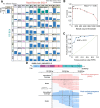Highly Multiplexed Reverse-Transcription Loop-Mediated Isothermal Amplification and Nanopore Sequencing (LAMPore) for Wastewater-Based Surveillance
- PMID: 38633369
- PMCID: PMC11019537
- DOI: 10.1021/acsestwater.3c00690
Highly Multiplexed Reverse-Transcription Loop-Mediated Isothermal Amplification and Nanopore Sequencing (LAMPore) for Wastewater-Based Surveillance
Abstract
Wastewater-based surveillance (WBS) has gained attention as a strategy to monitor and provide an early warning for disease outbreaks. Here, we applied an isothermal gene amplification technique, reverse-transcription loop-mediated isothermal amplification (RT-LAMP), coupled with nanopore sequencing (LAMPore) as a means to detect SARS-CoV-2. Specifically, we combined barcoding using both an RT-LAMP primer and the nanopore rapid barcoding kit to achieve highly multiplexed detection of SARS-CoV-2 in wastewater. RT-LAMP targeting the SARS-CoV-2 N region was conducted on 96 reactions including wastewater RNA extracts and positive and no-target controls. The resulting amplicons were pooled and subjected to nanopore sequencing, followed by demultiplexing based on barcodes that differentiate the source of each SARS-CoV-2 N amplicon derived from the 96 RT-LAMP products. The criteria developed and applied to establish whether SARS-CoV-2 was detected by the LAMPore assay indicated high consistency with polymerase chain reaction-based detection of the SARS-CoV-2 N gene, with a sensitivity of 89% and a specificity of 83%. We further profiled sequence variations on the SARS-CoV-2 N amplicons, revealing a number of mutations on a sample collected after viral variants had emerged. The results demonstrate the potential of the LAMPore assay to facilitate WBS for SARS-CoV-2 and the emergence of viral variants in wastewater.
© 2024 The Authors. Published by American Chemical Society.
Conflict of interest statement
The authors declare no competing financial interest.
Figures


Similar articles
-
Diagnosis of SARS-CoV-2 Infection with LamPORE, a High-Throughput Platform Combining Loop-Mediated Isothermal Amplification and Nanopore Sequencing.J Clin Microbiol. 2021 May 19;59(6):e03271-20. doi: 10.1128/JCM.03271-20. Print 2021 May 19. J Clin Microbiol. 2021. PMID: 33782112 Free PMC article.
-
A New Method to Detect Variants of SARS-CoV-2 Using Reverse Transcription Loop-Mediated Isothermal Amplification Combined with a Bioluminescent Assay in Real Time (RT-LAMP-BART).Int J Mol Sci. 2023 Jun 27;24(13):10698. doi: 10.3390/ijms241310698. Int J Mol Sci. 2023. PMID: 37445876 Free PMC article.
-
Long-term monitoring of SARS-CoV-2 variants in wastewater using a coordinated workflow of droplet digital PCR and nanopore sequencing.Water Res. 2024 May 1;254:121338. doi: 10.1016/j.watres.2024.121338. Epub 2024 Feb 18. Water Res. 2024. PMID: 38430753
-
Development and Clinical Application of a Rapid and Sensitive Loop-Mediated Isothermal Amplification Test for SARS-CoV-2 Infection.mSphere. 2020 Aug 26;5(4):e00808-20. doi: 10.1128/mSphere.00808-20. mSphere. 2020. PMID: 32848011 Free PMC article.
-
Evaluation of colorimetric RT-LAMP for screening of SARS-CoV-2 in untreated wastewater.Sci Total Environ. 2024 Jan 10;907:167964. doi: 10.1016/j.scitotenv.2023.167964. Epub 2023 Oct 20. Sci Total Environ. 2024. PMID: 37865239
Cited by
-
Advances in Wastewater-Based Epidemiology for Pandemic Surveillance: Methodological Frameworks and Future Perspectives.Microorganisms. 2025 May 21;13(5):1169. doi: 10.3390/microorganisms13051169. Microorganisms. 2025. PMID: 40431340 Free PMC article. Review.
References
-
- Cariti F.; Tuñas corzon A.; Fernandez-cassi X.; Ganesanandamoorthy P.; Ort C.; Julian T. R.; Kohn T. Wastewater Reveals the Spatiotemporal Spread of SARS-CoV-2 in the Canton of Ticino (Switzerland) during the Onset of the COVID-19 Pandemic. ACS EST Water 2022, 2 (11), 2194–2200. 10.1021/acsestwater.2c00082. - DOI - PMC - PubMed
-
- Ahmed W.; Angel N.; Edson J.; Bibby K.; Bivins A.; O’brien J. W.; Choi P. M.; Kitajima M.; Simpson S. L.; Li J.; Tscharke B.; Verhagen R.; Smith W. J. M.; Zaugg J.; Dierens L.; Hugenholtz P.; Thomas K. V.; Mueller J. F. First Confirmed Detection of SARS-CoV-2 in Untreated Wastewater in Australia: A Proof of Concept for the Wastewater Surveillance of COVID-19 in the Community. Sci. Total Environ. 2020, 728, 13876410.1016/j.scitotenv.2020.138764. - DOI - PMC - PubMed
-
- Hellmér M.; Paxéus N.; Magnius L.; Enache L.; Arnholm B.; Johansson A.; Bergström T.; Norder H. Detection of Pathogenic Viruses in Sewage Provided Early Warnings of Hepatitis A Virus and Norovirus Outbreaks. Appl. Environ. Microbiol. 2014, 80 (21), 6771–6781. 10.1128/AEM.01981-14. - DOI - PMC - PubMed
LinkOut - more resources
Full Text Sources
Miscellaneous
